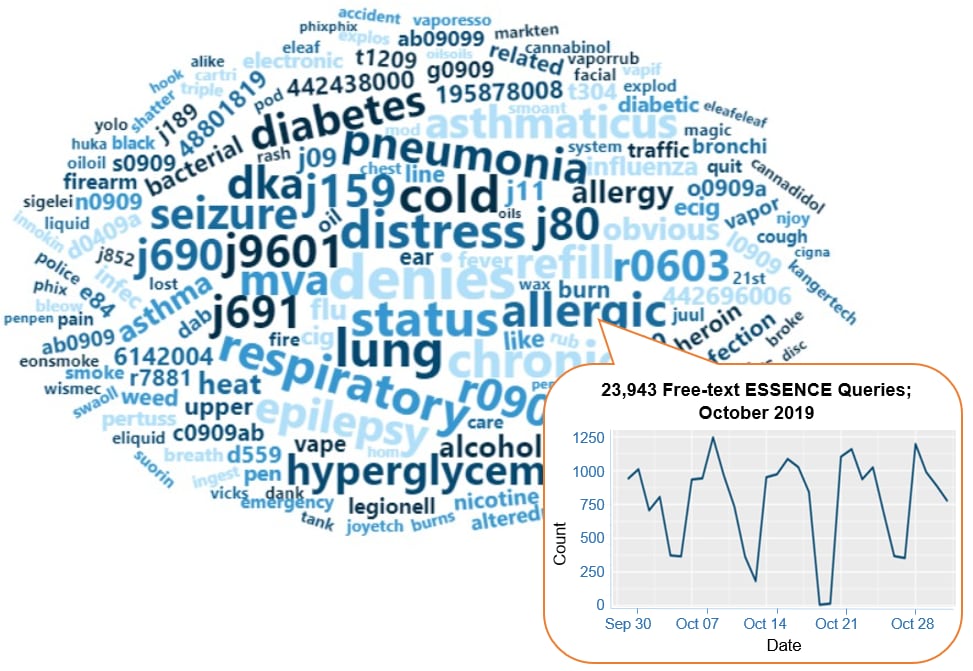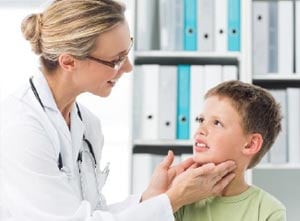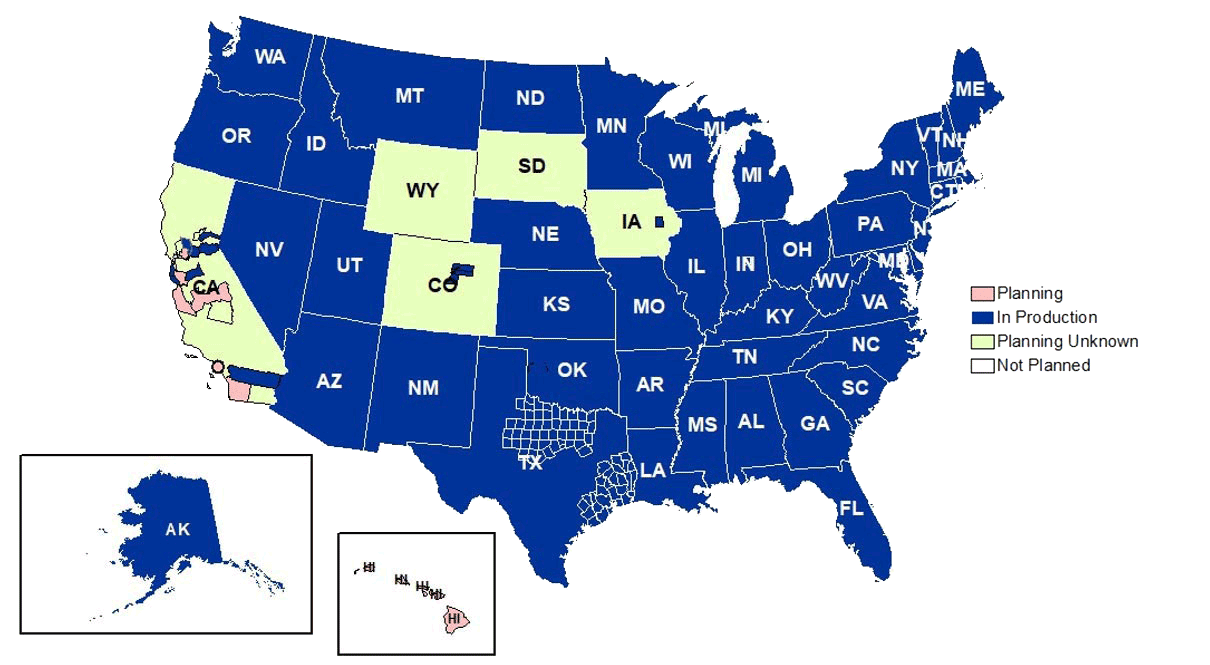NSSP Update – December 2019
Community of Practice

Community of Practice (CoP)
- CSTE assumed responsibility for facilitating the NSSP CoP after a competitive selection process.
- The Implementation Guide for Syndromic Surveillance was posted on the HL7 website and as a National Institute of Standards and Technology Authoring Tool.
- Data Quality Committee members collaborated with vendors to get insight into and start discussions on specific data quality topics, volunteered for usability accessibility testing of NSSP projects (e.g., dashboard), and discussed concerns about triage notes.
- The Overdose Surveillance Committee shared information about new resources and emerging surveillance topics, engaged data owners to present data sources to practitioners who conduct relevant overdose surveillance, and discussed other data sources for overdose surveillance.
- SPHERR held 36 Practice Exchange calls, presented to CSTE’s Disaster Epidemiology Subcommittee; participated in CSTE’s Emergency Management Collaboration Workgroup; and presented at the 2019 ISDS Conference and 2019 NACCHO Preparedness Summit.
- The Syndrome Definition Committee— recognized at the ISDS Conference as “Most Engaged Group”—released a syndrome definition and validation guidance document; developed a definition for disaster-related mental health; established itself as a syndrome definition resource; and led an ad-hoc call about vaping-related lung injuries.
- The Technical Committee set up an ESSENCE Data Dictionary Workgroup, improved documentation for NSSP Service Desk tickets, and obtained community input on modifications to the BioSense Platform.
- The Urgent Care Subcommittee continued to review related literature and conducted quarterly meetings to discuss onboarding, best practices, and other topics.
NSSP CoP Celebrates 2019 Achievements
For inspiring stories about achievements in syndromic surveillance (SyS), check out last month’s call: The Year in Review: What have Committees been up to? Learn how each committee advances SyS science and practice. Committee participation is the best way to have your voice heard, be “in the know,” and be part of the solution.
Speakers, in order of presentation, follow:
- Howard Burkom (Johns Hopkins University Applied Physics Laboratory)
Burkom described an alert-prioritizing algorithm for potential ESSENCE use and explained how the sorting algorithm will adjust alerts to an ideal prioritization order. - Eunice Santos—Data Quality Committee
The committee’s plans for 2020 include identifying new analytic methods and data sources. - Dave Swenson—Urgent Care Subcommittee
The subcommittee plans to continue sharing the American Hospital Association’s guidance to encourage greater adoption of urgent care centers with hopes of improving rural health access to care. - Charlie Ishikawa—SPHERR (Syndromic Surveillance and Public Health Emergency Preparedness, Response and Recovery Committee)
Upcoming plans include conducting the Syndromic Surveillance Rapid Response Functional Exercise (SSURRF-EX) that will enable regional groups to share data on ESSENCE to exercise SyS use during a public health emergency. SPHERR also plans to develop an SyS and Emergency Management Integration Guidance Document. - Natasha Close—Technical Committee
Plans for 2020 include developing an “everyday” ESSENCE Data Dictionary, testing ESSENCE, and reviewing and prioritizing NSSP Service Desk support requests. - Rasneet Kumar—Syndrome Definition Committee
Plans for 2020 include disseminating a disaster-related mental health syndrome, working on new syndrome definitions, and developing a new process for submittals to the Syndrome Library. - Peter Rock—Overdose Surveillance Committee
Plans for 2020 include drafting a data validation plan; engaging with states funded to prevent opioid overdose to share ideas and brainstorm response plans; and encouraging communication across public health jurisdictions.
Are you interested in joining the NSSP CoP or one of its committees? For information, please email syndromic@cste.org.
Update Your NSSP CoP Links
The members at CSTE, the professional home for applied epidemiologists, are proud to support the syndromic surveillance community. Learn more about the NSSP CoP HERE and access the NSSP CoP Knowledge Repository HERE.
CSTE is also developing an online collaborative space for the NSSP CoP and its committees. In the interim, this Basecamp will serve as the collaborative space for the NSSP CoP where you can find call recordings, slides, and brief notes from committee meetings. These resources will also continue to be provided on the Knowledge Repository.
How to Submit Content to Knowledge Repository
CSTE is now curating materials for the NSSP CoP. If you have a syndrome definition to submit or SyS-related resources that you’d like considered for upload to the Knowledge Repository, please contact CSTE at syndromic@cste.org. CSTE will also start archiving nice-to-have historic documents that are no longer cutting-edge resources or have been updated or replaced.
NSSP Refreshes Website
As part of a CDC website redesign, NSSP looked at all of the different websites we had representing NSSP and the community and consolidated technical resources into one location for ease of use and efficiency:
NSSP Website

The NSSP website (https://www.cdc.gov/nssp/index.html) has a new look that explains syndromic surveillance (SyS) to a high-level audience and shows SyS in action with many of the great success stories from our state and local public health department partners. It also explains how NSSP works across CDC to partner with other programs to develop syndromes and respond to health events such as the opioid overdose epidemic and vaping lung disease outbreak.
NSSP Technical Resource Center

The NSSP Technical Resource Center at https://www.cdc.gov/nssp/resources.html has been refreshed with a modern design and now includes in one location all the technical resources that you may need to do your job. We invite you to bookmark this page.
On the page, you will now find links to the BioSense Platform and its tools, the Knowledge Repository, and the NSSP Community of Practice website.
In addition, on this page we have located links to the NSSP Update newsletter, NSSP technical publications, tips and trainings, a data quality corner, and much more! The NSSP Technical Resource Center is your one-stop-shop for all the technical resources you may need!
Technical Publications and Standards

On the NSSP Technical Resource Center, please note the button for a new page called “Technical Publications and Standards” at https://www.cdc.gov/nssp/technical-pubs-and-standards.html. We invite you to bookmark this page.
Here, we have onboarding materials, quick start guides, a data dictionary, message mapping guides, standards, and other technical documents in one spot for your easy reference.
ESSENCE Queries: October 2019

A key feature of NSSP–ESSENCE is its ability to use free-text definitions across different fields to generate custom queries. The syndromic surveillance community can use this feature to develop and refine category definitions and to identify and respond to public health events that may not be apparent in established categorical definitions (i.e., syndromes, subsyndromes, and Chief Complaint and Discharge Diagnosis [CCDD] categories).
This word cloud summarizes free-text and coded values that epidemiologists and data analysts queried in ESSENCE during October 2019. We created it by using the Wordcloud2 package in RStudio. The relative size of the terms suggests the frequency of use in a query. NSSP super administrators can query ESSENCE usage logs to learn what queries are run nationwide and how long they take to complete.
CDC Funding Recipients and Partnership Updates

Funding Recipients and Partnerships
- Closed-out the NSSP cooperative agreement that ended August 31, 2019.
- Shared best practices, challenges, and successes at a cooperative agreement close-out meeting in Atlanta, Georgia.
- Reduced NSSP administrative burden by integrating syndromic surveillance activities into the Health Information Systems Capacity component of CDC’s Epidemiology and Laboratory Capacity for Infectious Diseases cooperative agreement.
- Participated in a series of CSTE-facilitated regional data-sharing workshops.
- Participated in a capstone meeting in Atlanta, Georgia, to share results from the regional data-sharing workshops.
- Participated in CDC’s national public health effort to reduce opioid overdose.
- Participated in CDC’s national effort to understand lung injuries associated with vaping.
How the Community Strengthens Syndromic Surveillance Science and Practice
- On August 31, 2019, and after extensive planning, the NSSP closed out its cooperative agreement and merged into the Health Information Systems component of CDC’s Epidemiology and Laboratory Capacity (ELC) for Infectious Diseases cooperative agreement.
Both cooperative agreements share the overarching goals of advancing electronic data exchange and sustaining health information systems to inform public health decision making. The merger consolidated administrative efforts within CDC and should better support the long-term needs of programs and partners.
- More recently, site administrators and their ELC program consultants have been developing a comprehensive list of emergency departments (EDs) for each public health jurisdiction. Once the lists and the Master Facility Table (MFT) have been reconciled, the MFT will be the “one-stop shop” for facility information.
Collaborations

Tennessee Uses Syndromic Surveillance to Identify Potential Cases of Mumps
Sometimes incidents of public health importance are not readily detected and initially go unreported using traditional surveillance systems. Each time a case is not reported, it is a lost opportunity to understand disease trends and prevent outbreaks. The Tennessee Department of Health routinely monitors syndromic data for conditions of immediate public health interest—such as measles, mumps, and rubella. Syndromic data can reveal potential unreported cases and flag incidents that may be of interest to public health. By integrating syndromic data into a comprehensive surveillance system, Tennessee identifies potential cases of mumps and other reportable diseases in near real-time before becoming missed opportunities to protect the public’s health.
See the full story.
Firearm Injury Syndrome Definition Added to ESSENCE
The National Syndromic Surveillance Program (NSSP) developed a syndromic surveillance query for identifying suspected emergency department visits related to firearm injuries. This query, now available on NSSP–ESSENCE, can be used to complement efforts by states and health jurisdictions to analyze these types of injuries and identify patterns.
The “CDC Firearm Injury Version 1” query accesses Chief Complaint and Discharge Diagnosis fields to identify first-time visits for firearm-related injuries. The query excludes subsequent visits related to the initial firearm injury or its sequelae. The query searches for the following terms, including common spellings and misspellings: GSW; gunshot; buckshot; firearm; handgun; pistol; revolver; rifle; shotgun; been shot; I was shot; I got shot; gun in combination with wound; and the terms hit, ricochet, or graze in combination with the term bullet. The query also searches for ICD-10-CM, ICD-9-CM, and SNOMED diagnosis codes for firearm injuries for the following types of intent: unintentional, intentional self-harm, assault, legal intervention, terrorism, and undetermined intent. In addition, the query contains negation terms that, for example, exclude visits for injuries related to water, pellet, BB, rubber, paint, nerf, air, spring, nail, staple, stun, laser, or Taser guns.
While not intended to provide prevalence estimates, syndromic surveillance coordinators and epidemiologists at national, state, and local levels can use this query to understand trends and clustering of visits for firearm-related injury. This query has been rigorously validated. Still, feedback from health jurisdictions using this syndromic surveillance query, in addition to further validation, will help determine next steps toward refining and improving the syndrome definition.
Our thanks to Epidemiologist Marissa Zwald (National Center for Injury Prevention and Control, Division of Violence Prevention) and Health Scientist Nimi Idaikkadar (Center for Surveillance, Epidemiology, and Laboratory Services; Division of Health Informatics and Surveillance) for this update.
Collaborations Accelerate Syndromic Surveillance Practice

Collaborations between health departments and CDC programs are improving how syndromic surveillance (SyS) gets done. The list of collaborations that follows, while not exhaustive, summarizes ongoing efforts to develop and improve syndrome definitions, conduct pilot tests and exercises, and improve processes to achieve public health goals more efficiently:
- Develop syndrome definition for alcohol-involved emergency department visits.
- Collaborator: Opioid and Overdose Team
- JUST RELEASED! Check out the syndrome in ESSENCE.
- Develop syndrome definition for pregnancy, delivery, and miscarriage.
- Collaborator: CDC’s Maternal and Infant Health/Maternal and Infant Health Branch (MIHB)
- Develop syndrome definition for injecting drug users and endocarditis (infection of inner lining of heart chamber and valves).
- Collaborator: CDC’s National Center for Emerging and Zoonotic Infectious Diseases, Epidemiology Research and Innovations Branch
- Develop syndrome definition for e-scooter-related injuries. NSSP is part of the Transportation Safety Team’s e-scooter working group.
- Collaborator: CDC’s Division of Unintentional Injury Prevention and the Transportation Safety Team
- Develop syndrome definition for motor vehicle collision syndrome.
- Collaborator: CDC’s Division of Unintentional Injury Prevention and the Transportation Safety Team
Want help meeting surveillance goals?
Collaborate.
Engage NSSP, CDC programs, or health jurisdictions about special projects by emailing
nssp@cdc.govDevelop syndrome definition for child abuse and neglect.
- Collaborator: CDC’s Division of Violence Prevention
- Develop syndrome definition for child sexual abuse.
- Collaborator: CDC’s Division of Violence Prevention
- Develop syndrome definition for sex trafficking.
- Collaborator: CDC’s Division of Violence Prevention
- Develop syndrome definition for teen dating violence.
- Collaborator: CDC’s Division of Violence Prevention
- Develop syndrome definition for homeless populations.
- Collaborator: CDC’s Division of Violence Prevention
- Develop syndrome definition for animal bites.
- Develop syndrome definition for marijuana v3.
- Collaborator: CDC’s Opioid and Overdose Team
- Develop syndrome definition for synthetic marijuana.
- Collaborator: CDC’s Opioid and Overdose Team
- Update syndrome definition for Influenza-like Illness (ILI) CCDD category.
- Collaborator: CDC’s Influenza Division
- NSSP is evaluating the detection methods for CC, DD, and CCDD fields to identify whether field choice affects how signals or alerts are created. NSSP will test multiple algorithms to filter for the most meaningful alerts in accord with detection methods. Afterwards, NSSP will develop best practices for using detection methods.
- NSSP is working with CDC’s National Center for Environmental Health on strategies to capture radiation exposures following a radiation disaster. They are examining how syndromic data can be used to supplement existing radiation exposure surveillance using poison control center data.
- NSSP is participating in a functional exercise to gauge how well the community shares information and data during a public health event. This exercise will evaluate response speed; technical needs and delivery options; potential local, state, and federal collaborations; and integration of emergency preparedness and management personnel.
- Collaborator: NSSP CoP Syndromic Surveillance and Public Health Emergency Preparedness Response and Recovery Committee
- NSSP is working with CDC’s National Center for Chronic Disease Prevention and Health Promotion, Division of Cancer Prevention and Control, on a special-interest project though the Prevention Research Centers Program: “Improving Cancer Survivor Treatment and Outcomes by Ensuring Appropriate Emergency/Acute Care Treatment.” Work began fall 2019 will extend through 2020.
The dates listed are approximations and can change. Our thanks to Health Scientist Nimi Idaikkadar (Center for Surveillance, Epidemiology, and Laboratory Services; Division of Health Informatics and Surveillance) for this update.
Data Quality Corner
The Year of Data Quality!

Data Quality
- Launched NSSP Data Quality Dashboard to provide a pulse read of the general health of data flow and data content.
- DQ metrics at your fingertips!
- Troubleshooting on the front line!
- Defined and implemented “non-informative chief complaint” terms, called NICCs, that enable selective analysis on visits that contain only informative and meaningful chief complaints.
- Conducted Daily Site Status Checks that begin by reviewing the Lights On Report. NSSP looks at issues flagged by the report and assesses trend lines for site visits (in ESSENCE) to check NSSP’s processing performance.
- Introduced ESSENCE Data Quality Filter to track and enhance data quality for Chief Complaint and Discharge Diagnosis.

- NSSP shares your commitment to improving both data quality and the tools you use daily to monitor data processing and content. In fall 2019, we achieved our collective goal to deploy the first iteration of the interactive Data Quality (DQ) Dashboard. We’re thrilled to report that many of you are already using this tool regularly and finding it helpful. You can view an introductory webinar to the DQ Dashboard here.
This multifunctional tool provides an at-a-glance view of the “health” of your data and prepares you to dive deeper into resolving data quality issues. Also, the DQ Dashboard provides download capability that lets you store tables and graphs and create reports. Encourage discussion with vendors and facility partners by sharing these reports to let them know how they are doing.
- Throughout the year, we expanded our repository of data quality reports in response to your interest in monitoring and assessing data quality:
- Detailed Excel DQ reports on data completeness, timeliness, and validity—delivered monthly
- Data-Quality-on-Demand SAS tool provides self-service delivery of detailed Excel DQ reports—you control delivery!
- Executive-level report highlighting DQ metrics—delivered quarterly
- Site Summary Processing emails that alert you to data processing and potential issues with end-to-end data flow—delivered daily
- Email alerts when active facilities are not sending data—delivered at 30-, 60-, and 90-day intervals
The NSSP team appreciates your commitment to data quality and looks forward to working with you on more innovative approaches to monitoring performance!

Data and Technology
- Launched Data Quality Dashboard
- Updated MFT (conducted feed name cleanup and facility audits; added vendor drop-downs and Batch Update)
- Updated AMC (April, December)
- Updated ESSENCE (March)
- Updated RStudio Pro
- Held User Acceptance Testing of AMC 1.1.5 Data Access Rules
- Introduced one-stop shop for SAS code to support application programming interfaces (APIs)
- Introduced Data Quality-on-Demand reporting
- Added Quarterly Metrics to Site Folders
Program Administration
- Integrated syndromic surveillance into Epidemiology and Laboratory Capacity cooperative agreement and assisted funded states
- Assisted state recipients of funding for Overdose Data to Action (CDC-RFA-CE19-1904D), built upon Enhanced State Opioid Overdose Surveillance program
- Assisted states that qualified for Notice of Funding Opportunity, Emergency Department Surveillance of Nonfatal Suicide-Related Outcomes
- Selected CSTE to facilitate NSSP-CoP
- Held Cooperative Agreement Close-out Meeting
- Held Data-Sharing Workshops for HHS Regions
- Began quarterly release of NSSP Participation and Coverage numbers
- Conducted NSSP BioSense Platform User Assessment
- Updated NSSP website
- Developed and initiated promotion of NSSP infographic
- Worked with Assistant Secretary for Preparedness and Response to assess hurricane season response
- Updated NSSP Service Desk
Publications
- Published success stories:
- Arizona Monitors Transfer of Patients with Suspected Rocky Mountain Spotted Fever
- DeKalb County, Georgia, Use of Syndromic Data to Identify Chlorine Gas Exposure at Swimming Pool
- Florida Use of Syndromic Surveillance to Identify Unreported Cases of Zika Virus Disease
- Louisiana Takes Action Against Drug Abuse
- Tennessee Use of Syndromic Surveillance to Identify Potential Cases of Mumps
- West Virginia Use of Syndromic Surveillance to Monitor Mass Gatherings
- Introduced BioSense Platform Enhancements Document
- Updated Data Dictionary and “Journeys” guide
- Worked with the community on final edits to Implementation Guide for Syndromic Surveillance
Publications, continued
- Did substantial development of Quick Start Guides:
- Using the AMC (published)
- AMC Data Access Rules
- Using the Daily Site Processing Summary
- Using RStudio Pro
- Using SAS Studio
- Published NSSP Update monthly newsletter
- 6-part series on Free-text Coding in NSSP–ESSENCE
- Calendar heatmaps for visualizing time-series data
- Questions and tips about APIs
- Free-text ESSENCE queries by month
- Developed DQ Dashboard Manual
- Co-authored “Building State and Local Capacity in Syndromic Surveillance Through an Online Community of Practice” (May/June 2019; Public Health Reports)
Collaboration
- Launched newsletter feature: “Collaborations Accelerate SyS Practice”
- Presented at 2019 International Society for Disease Surveillance conference
- What Can you REALLY do with 35,000 Statistical Alerts a Week?
- Use of ESSENCE APIs
- Using Evaluation to Inform the BioSense Platform
- Customizing ESSENCE Queries for Select Mental Health Sub-Indicators
- Assessed Use of BioSense Platform to report to ILINet
- Supported CDC’s national response to the opioid crisis
- Supported CDC’s multistate lung injury response and worked with CDC’s Injury Center to develop syndromes
- Participated in joint efforts to introduce syndromes:
- Alcohol-involved emergency department visits
- Bacterial tickborne Lyme disease
- Diabetic ketoacidiosis (a life-threatening but avoidable complication of diabetes when high levels of blood acids, ketones, are produced)
- Drowning and submersion
- Measles (Rubeola) V1
- Medication refill during/after public health disaster
- Pertussis (whooping cough)
- Sexual violence V3
- Tick exposures
- Began evaluation of detector methods for CC, DD, and CCDD fields
- Began work on joint effort to capture radiation exposures following radiation disaster
- Participated in functional exercise to gauge how well the community shares information and data during a public health event
Technical Updates
NSSP Deploys Updates to Access & Management Center (AMC)
At the time of publication, the NSSP team had just deployed updates to the AMC Staging and Production systems. AMC performance is a high priority because control of data access is central to NSSP functions.
Current Month and Upcoming Events
| December 3 | Deploy AMC v1.5.1 to Onboarding (Staging) system |
| December 5 | Deploy AMC v1.5.1 to Production system |
| December 19 | Make vendor patches in staging and production environments: 6:00–10:00 AM ET |
Last Month’s Technical Assistance
| November 6 | Held Data Validation Conference Call |
| November 21 | Applied vendor patches to both onboarding and production environment |
NSSP Participation and Coverage
Participation: The map below shows participation in NSSP as of September 2019, with 59 sites (47 states and the District of Columbia).

Definitions: NSSP consolidates facilities that provide data under a single data administrative authority called a site administrator. These facilities and single-site administrator constitute a site.
Coverage: NSSP publishes data for emergency department (ED) visit coverage each quarter. As of September 30, 2019, data from EDs covered about 70% of all ED visits in the country. There were 4,657 facilities, including 3,119 emergency EDs from 59 sites (47 states and the District of Columbia), actively contributing data to the NSSP BioSense Platform. The calculation method is described in the December 2018 issue of NSSP Update.

